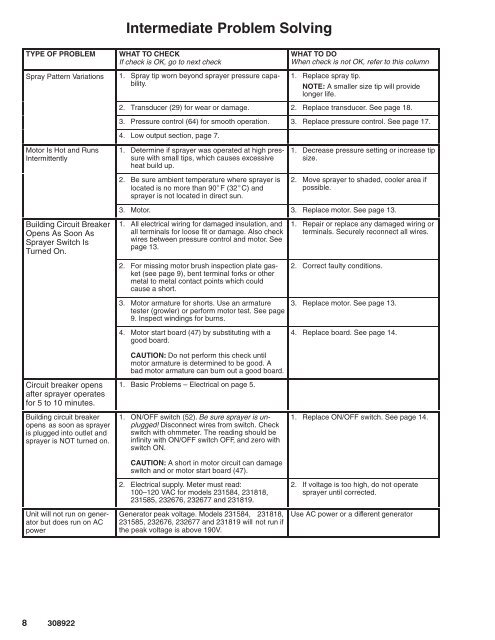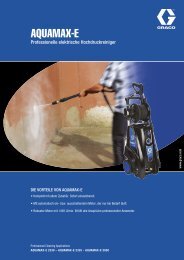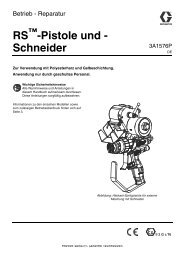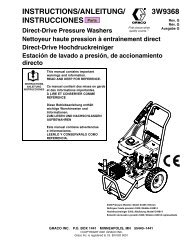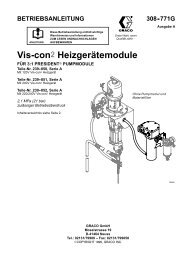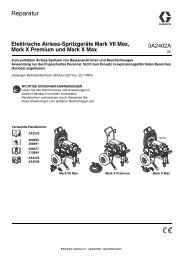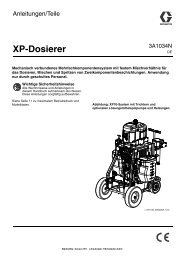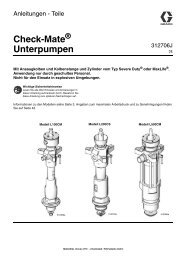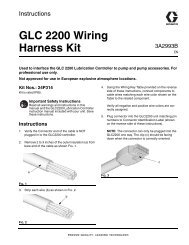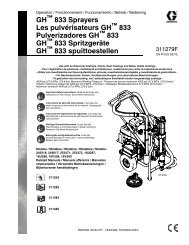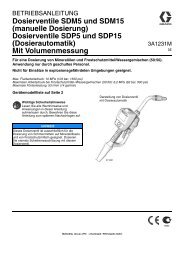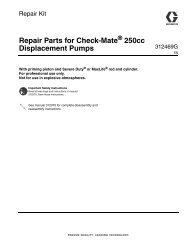308922B 495st Airless Paint Sprayers - Graco Inc.
308922B 495st Airless Paint Sprayers - Graco Inc.
308922B 495st Airless Paint Sprayers - Graco Inc.
You also want an ePaper? Increase the reach of your titles
YUMPU automatically turns print PDFs into web optimized ePapers that Google loves.
Intermediate Problem Solving<br />
TYPE OF PROBLEM<br />
WHAT TO CHECK<br />
If check is OK, go to next check<br />
WHAT TO DO<br />
When check is not OK, refer to this column<br />
Spray Pattern Variations 1. Spray tip worn beyond sprayer pressure capability.<br />
1. Replace spray tip.<br />
NOTE: A smaller size tip will provide<br />
longer life.<br />
2. Transducer (29) for wear or damage. 2. Replace transducer. See page 18.<br />
3. Pressure control (64) for smooth operation. 3. Replace pressure control. See page 17.<br />
4. Low output section, page 7.<br />
Motor Is Hot and Runs<br />
Intermittently<br />
1. Determine if sprayer was operated at high pressure<br />
with small tips, which causes excessive<br />
heat build up.<br />
2. Be sure ambient temperature where sprayer is<br />
located is no more than 90F (32C) and<br />
sprayer is not located in direct sun.<br />
1. Decrease pressure setting or increase tip<br />
size.<br />
2. Move sprayer to shaded, cooler area if<br />
possible.<br />
3. Motor. 3. Replace motor. See page 13.<br />
Building Circuit Breaker<br />
Opens As Soon As<br />
Sprayer Switch Is<br />
Turned On.<br />
Circuit breaker opens<br />
after sprayer operates<br />
for 5 to 10 minutes.<br />
Building circuit breaker<br />
opens as soon as sprayer<br />
is plugged into outlet and<br />
sprayer is NOT turned on.<br />
Unit will not run on generator<br />
but does run on AC<br />
power<br />
1. All electrical wiring for damaged insulation, and<br />
all terminals for loose fit or damage. Also check<br />
wires between pressure control and motor. See<br />
page 13.<br />
2. For missing motor brush inspection plate gasket<br />
(see page 9), bent terminal forks or other<br />
metal to metal contact points which could<br />
cause a short.<br />
3. Motor armature for shorts. Use an armature<br />
tester (growler) or perform motor test. See page<br />
9. Inspect windings for burns.<br />
4. Motor start board (47) by substituting with a<br />
good board.<br />
CAUTION: Do not perform this check until<br />
motor armature is determined to be good. A<br />
bad motor armature can burn out a good board.<br />
1. Basic Problems – Electrical on page 5.<br />
1. ON/OFF switch (52). Be sure sprayer is unplugged!<br />
Disconnect wires from switch. Check<br />
switch with ohmmeter. The reading should be<br />
infinity with ON/OFF switch OFF, and zero with<br />
switch ON.<br />
CAUTION: A short in motor circuit can damage<br />
switch and or motor start board (47).<br />
2. Electrical supply. Meter must read:<br />
100–120 VAC for models 231584, 231818,<br />
231585, 232676, 232677 and 231819.<br />
Generator peak voltage. Models 231584, 231818,<br />
231585, 232676, 232677 and 231819 will not run if<br />
the peak voltage is above 190V.<br />
1. Repair or replace any damaged wiring or<br />
terminals. Securely reconnect all wires.<br />
2. Correct faulty conditions.<br />
3. Replace motor. See page 13.<br />
4. Replace board. See page 14.<br />
1. Replace ON/OFF switch. See page 14.<br />
2. If voltage is too high, do not operate<br />
sprayer until corrected.<br />
Use AC power or a different generator


